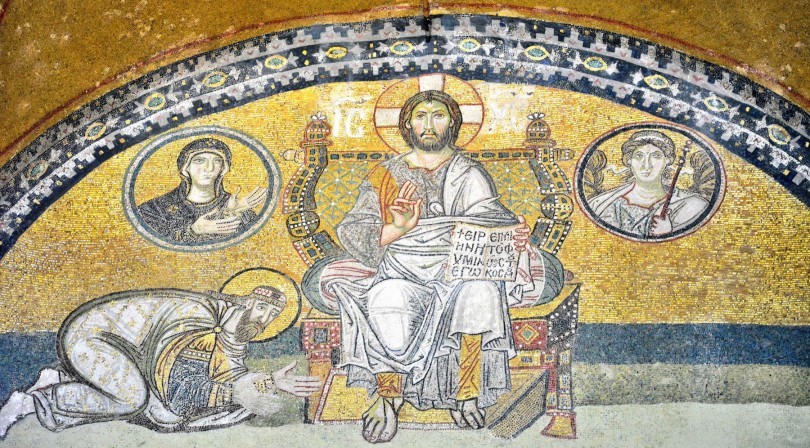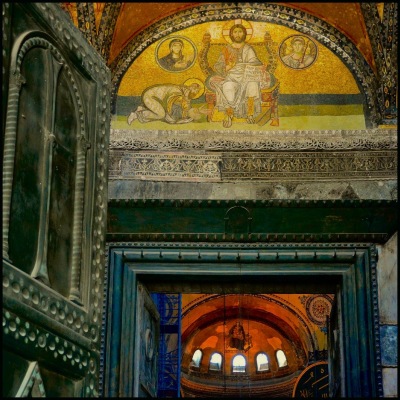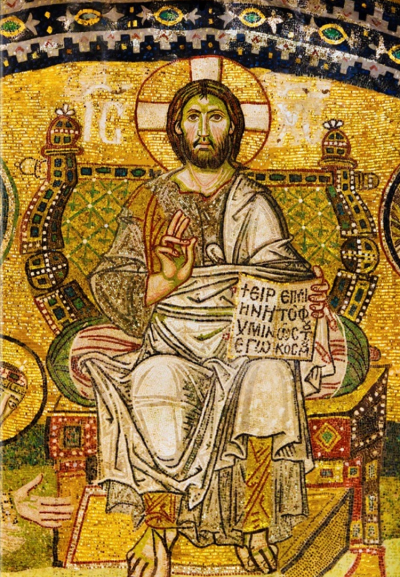
The Leo VI mosaic is fascinating because it is more complex than other mosaics in a certain sense. Not in its the quality of the mosaic itself in terms of artistic ability, but in terms of its identity and meaning. This mosaic is usually and probably correctly identified as Leo VI, also known as Leo the Wise” (Λέων ὁ Σοφός) who ruled from 886-912. It is located in the apse above the Imperial door, which is according to tradition made of wood from Noah’s Ark. In this mosaic, it has Christ enthroned in the middle. He has his right hand raised for blessing, and his left hand rests on his left knee holding a holy book. The inscription translates to “Peace to you, I am the light of the world.” On each side of Christ are two unlabeled portraits. One is clearly the Theotokos, and the other an unidentifiable Angel. The left side of the mosaic shows the Emperor Leo, in a prostrate position raising his hands towards Christ. The right side is unusually empty. The meaning of this work of art can be interpreted differently.

There is general scholarly agreement it is from the late 9th or early 10th century. Thomas Whittemore who had helped restore the mosaic in 1933 proposed Leo VI, and thought the two portraits were the Theotokos and Gabriel, based on an ivory work of Leo in Berlin. The mosaic shows the Emperor in an unflattering position that suggests repentance. Supporting this, according to Nicolas Oikonomides is the Byzantine illustrations depicting the repentance of King David. Some scholars have tried to argue for Basil I as the Emperor. But physical descriptions undermine that argument. The fact Leo had four marriages could be the reason Leo is in this mosaic. This was very sinful according to the Church, and they did not want to certify the fourth. At some point Leo was banned from Hagia Sophia by the Patriarch Mystikos. In front of the very same Imperial door as the mosaic, Leo was reportedly on the ground weeping. He rose and said to the Patriarch “…for the multitude of my unmeasured trespasses, rightly and justly I am suffering.” During Leo’s last years he was humbly admitted as a penitent, which was a humiliation. It seems unlikely an Emperor chose this image for himself. There is a chance that Nicholas Mystikos, the Patriarch deposed by Leo, and his successor Alexander could have put it up.

Leo’s successor Alexander could have put it up to show an impious Emperor begging for forgiveness, in contrast to showing himself as a pious Emperor in good standing. During the reign of Romanos Lekepanos, the Church finalized it’s stance on remarriages in 920. A second marriage was ok, a third was sinful but acceptable with special circumstances and with acts of penitence, a fourth was not acceptable. Mystikos saw this as a great victory for himself and the Church, and it is very possible the mosaic was then put up. The mosaic can be interpreted as the victory of the Patriarch Mystikos and the Church over the Emperor, and a warning to future Emperors who all walked through the Imperial door. The Church could deny an Emperor now just as Ambrose of Milan did to Theodosius the Great.

